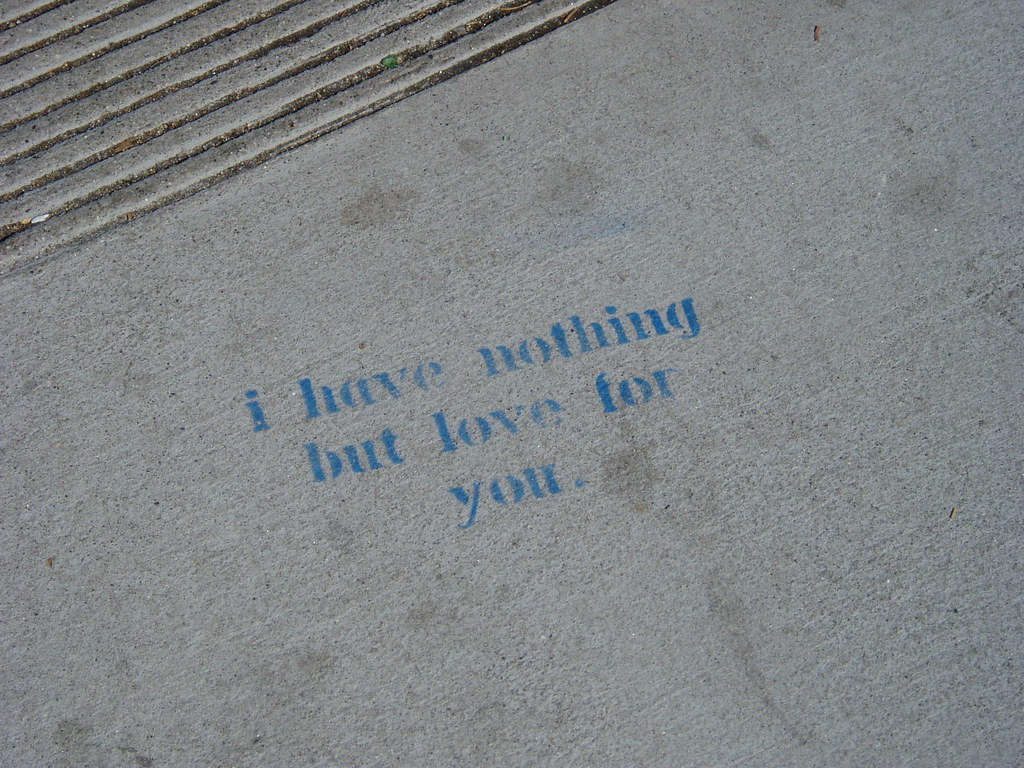MARKET STREET, 6:30 am
No shoes
Shuffles toward me
Eyes rolling
Cadges a smoke
Hands dirtier than
Hands can possibly be
Startles at my lighter
As if I had slapped him
Wanders away
Cigarette unlit

Pavement graffiti, Market St., San Francisco
Shuffles toward me
Eyes rolling
Cadges a smoke
Hands dirtier than
Hands can possibly be
Startles at my lighter
As if I had slapped him
Wanders away
Cigarette unlit

Pavement graffiti, Market St., San Francisco
Market Street cuts across San Francisco for three miles (4.8 km) from the waterfront to the hills of Twin Peaks. It begins at The Embarcadero in front of the Ferry Building at the northeastern edge of the city and runs southwest through downtown, passing the Civic Center and the Castro District, to the intersection with Corbett Ave. in the Twin Peaks neighborhood. As Portola Dr. it extends south to the intersection of St. Francis and Sloat Bvds. and then continues as Junipero Serra Bvd. It was laid out by Jasper O'Farrell, an Irish civil engineer who he emigrated to California in 1843. Employed by the Mexican government, he surveyed much of Marin and Sonoma counties and was one of the first settlers of Sebastopol, where he purchased Rancho Estero Americano. He named the valley after Annaly, Ireland, the home of the O'Farrell family, and became a major landholder in the Sonoma area. [To counter the Russian presence at Ft. Ross, in 1835 the military commander built the Presidio of Sonoma and sent Edward McIntosh, James Black, and James Dawson to extend settlement in that direction. Black settled at Rancho Cañada de Jonive, while Dawson and McIntosh settled at Rancho Estero Americano, but the two men quarrelled over the land in 1839; Dawson sawed the house in which they had been living in two and removed his half to Rancho Cañada de Pogolimi.] In 1848 O’Farrell obtained Rancho Cañada de Jonive by trading his Rancho Nicasio holding for Black's Rancho Cañada de Jonive, and in 1849 he bought Rancho Estero Americano from McIntosh. He was also a claimant for Rancho Cañada de Capay. In 1846 he witnessed the murders of José de los Reyes Berreyesa and the sons of Francisco De Haro by troops under the command of John C. Frémont, during the American conquest of California; his account was one of the many incidents that hindered Frémont's political career (though Frémont was California's first senator and the first Republican candidate for president of the United States, in addition to being one of the chief generals in the early party of the Civil War). [O'Farrell himself was elected to the state senate in 1858.] After the American takeover of Yerba Buena (renamed San Francisco), the military government hired him to do a new land survey of the city in 1847. He repaired the original layout of the town around Portsmouth Square and then established Market as the widest street in town, at 120 ft (37 m) between property lines. It was described at the time as an arrow aimed straight at "Los Pechos de la Chola" (the Breasts of the Maiden), now called Twin Peaks, and O'Farrell had to flee to Sonoma to escape being lynched.
ReplyDelete